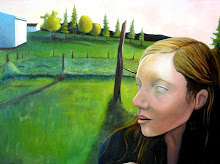Today I learned to do something that a woman my age in the eighteenth century would have already been an expert at. Spinning. I already knew quite a bit about textile production because I have to interpret our spinning room, but I'll go over it again so everyone out there reading this understands (if anyone is reading this). Then, I'll talk about my own experience spinning and how I relate to the women of colonial America.
To spin wool you first have to sheer the sheep, clean the wool, and then card it. Carding it is basically just combing it so all the fibers are strait and there aren't any knots. You have two brushes that look like wire dog brushes. You lay some wool on one and you draw the other brush over it, away from you. You repeat until the wool is fluffy and easy to get through. Then you roll the wool off of the brush, and it's ready to spin.
I spun on two different aparatuses. The first was a drop spindle. This is just a shaft with a disk around it, kind of like a short fencing sword. You just attach the wool to the spindle, let go of it so it's hanging in mid-air, and give it a spin. The fibers tighten into yarn. You continuously pull the wool tight so you get a nice thin, tight thread.
I also got to spin on a spinning wheel. This was much harder. First I just sat there and pumped the pedal to familiarize myself with the rythm. There was already some yarn on the spinning wheel, so I attached my wool to it. To do this I took some carded wool and overlapped it with some of the already spun thread. Then I gave the wheel of the spinning wheel a push and the spindle began to spin. By keeping the thread taught with your fingers you can get it to wind up like it does with the drop spindle. This is a lot harder than it sounds. You have to be consistent or else your yarn will be thicker in some places than it is in others. You also have to be able to pump with your foot, pinch the thread with your one hand, and pull the thread with the other. All the while if you let go for even a second your thread will break and get pulled through and wound up onto your spindle.
Women in colonial America spun A LOT. Sometimes eight hours a day. It was a symbol of femininity. Spinning was considered women's work. It was something that was done in the home, as opposed to weaving which was done professionally in some places. Nowadays it's just a hobby for most people. How do I feel about it. Well, someday when I move off of the grid I might want to make my own clothes. But for now, it just seems like too much work. I'd rather just buy my own clothes and have time to study history.
Subscribe to:
Post Comments (Atom)


No comments:
Post a Comment